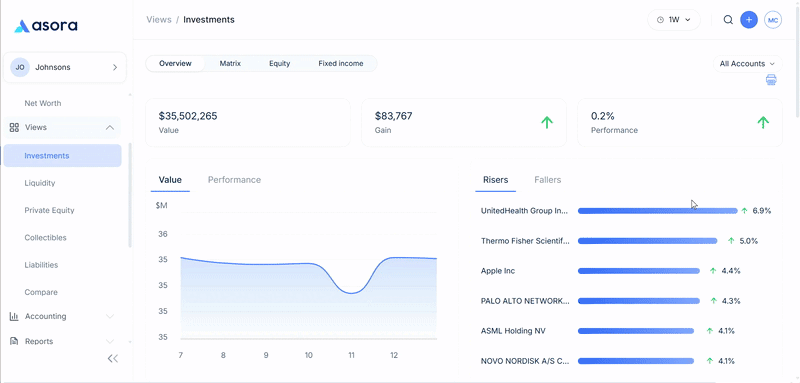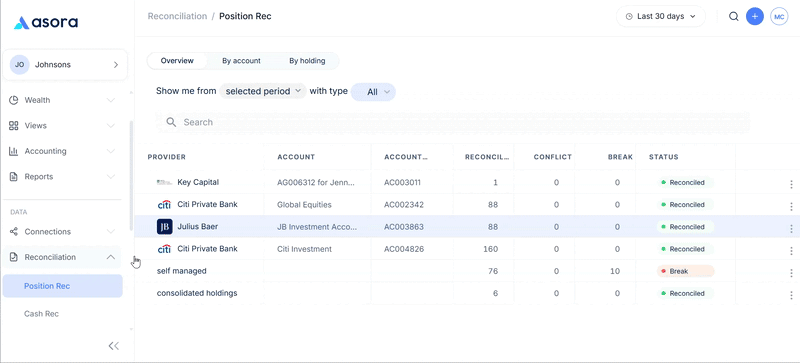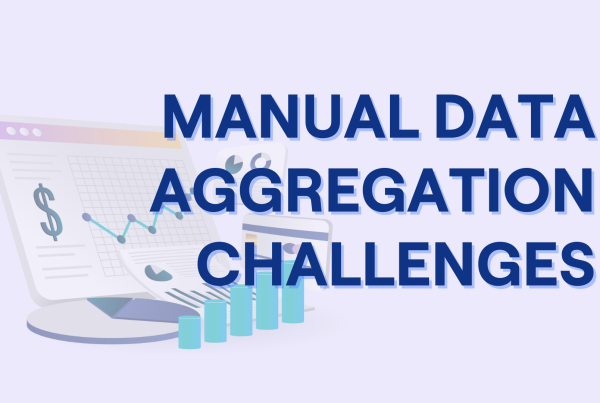TABLE OF CONTENTS
- TL;DR
- Introduction
- Why Family Office Dashboards Matter More Than Ever
- 4 Family Office Dashboards You Actually Need
- Why Data Aggregation Powers Everything
- How Dashboards Transform Family Office Operations
- Security Can’t Be an Afterthought
- What Makes a Great Dashboard
- Moving from Spreadsheets to Dashboards
- FAQ
TL;DR
Modern family offices are transitioning from spreadsheets and monthly PDFs to interactive dashboards that display live data across both public and private assets. The four dashboards that consistently add value are:
- Net worth and ownership
- Performance tracking
- Accounting oversight
- Data reconciliation
Together, these views shorten reporting cycles, improve the quality of decision-making, and provide principals, investment teams, and advisors with timely and consistent information.
Introduction
Family offices require faster and more precise visibility across complex structures and multiple asset classes. Dashboards that aggregate data automatically and refresh continuously replace manual compilation and delayed reporting, enabling reviews and decisions to be made based on current information rather than a snapshot from a previous month.
The shift is not only about speed. A well-designed dashboard aligns stakeholders with a single version of the truth, links figures back to their source data for auditability, and reduces the reconciliation workload that slows down the month-end close. Whether you operate a single family office or a multi-family office, the correct set of dashboards becomes the front door to your information, turning routine questions about allocation, liquidity, and risk into answers you can act on.
Why Family Office Dashboards Matter More Than Ever
Family offices can get complicated. It’s tracking:
- Liquid and illiquid assets across dozens of entities
- Real estate holdings in multiple countries
- Private equity investments with years-long time horizons
- Alternative investments like art collections, vintage cars, and venture capital funds
- Traditional stocks and bonds.
- Hedge funds.
Family office clients (especially the next generation) expect the same digital experience they get everywhere else in their lives. They want to check their net worth as easily as they check their phone. They want to understand how their portfolio performed this quarter without having to wait for someone to compile a report.
Meanwhile, your family office team is drowning in manual processes. Investment analysts are pulling data from five different custodian portals. Accountants are reconciling transactions across multiple systems. Operations staff are coordinating with wealth advisors to answer questions about cash balances and investment performance.
Modern family office software changes this. The dashboard serves as a single, accessible source of truth for wealth data, providing principals, advisors, and staff with a unified, current view.
4 Family Office Dashboards You Actually Need
Dashboard 1: Net worth & ownership

Start with three basics: where wealth is held by asset class, how it’s distributed across entities and vehicles, and who owns what within the family structure.
For many wealthy families (especially those spanning multiple generations), understanding the complete picture of family wealth can be surprisingly difficult. Assets might be held in trusts, holding companies, partnerships, and personal accounts. Some family members hold direct ownership, others have beneficial interests, and still others serve as trustees or advisors.
A comprehensive net worth dashboard in Asora provides a consolidated snapshot of total wealth. You can view the entire portfolio, broken down by asset classes, including equities, fixed income, real estate, private equity, alternative assets, and other categories. You can view it by liquidity (what you could access quickly versus long-term holdings). You can analyze concentration and risk exposure at a glance.
Look-through mode enables you to view beyond the investment structure to understand the underlying holdings, the structure of family trusts, and who ultimately benefits from each asset.
Estate planning becomes easier when you can visualize the complete ownership structure in one place. So does explaining the family’s financial position to the next generation of family members who are starting to take active roles.
Key features include:
- Integration from every source: banks, brokers, custodians, private equity administrators, and direct holdings.
- Timely automatic updates as values change and transactions occur.
- Filter and view timely data by person, entity, asset class, geography, or any other dimension that matters to your family office clients.
Dashboard 2: Performance

Start with four essentials: current performance across the whole portfolio, the status of illiquid holdings that report infrequently, available liquidity for capital calls and new opportunities, and the current valuation of collectables and other passion assets.
Performance isn’t just about returns. It’s about understanding the complete financial picture so you can make strategic decisions.
Public markets are usually easy. You can see real-time prices for stocks and bonds. But what about the venture capital fund that only reports quarterly? The commercial real estate partnership that sends annual updates? The art collection that needs periodic appraisals? The private credit positions that are illiquid but generating steady returns?
Traditional approaches to performance reporting often leave significant gaps or blind spots. The result is incomplete information, stale valuations, and a lack of a consistent method for comparing strategies.
Modern family office dashboards, like Asora, calculate automated daily time-weighted returns across your entire portfolio. They offer timely tracking of asset allocation, showing how your actual investments compare to your target allocation. They provide on-demand access to contribution analysis so you can see which decisions added or subtracted value.
For illiquid investments (private equity, venture capital, direct investments), effective performance dashboards track committed versus called capital, calculate IRR across various time periods, and display multiples on invested capital. You can slice this by provider, sector, vintage year, or other ways that help you understand what’s working.
Dashboards aggregate cash positions across banks and custodians to provide instant visibility for short-term liquidity planning and management. You know precisely how much cash you have and where it sits.
Dashboard 3: Accounting

Start with three key accounting essentials: realized and unrealized gains and losses across the portfolio, income by source and type (dividends, interest, and distributions), and recurring costs such as management and custody fees, as well as taxes.
Accounting visibility isn’t just about tax time. It’s about understanding the true cost of your investment strategy and having the data you need for tax planning throughout the year.
Without proper accounting oversight, you’re flying blind on some of the most important aspects of wealth management. You might not realize that fees are eating up more return than you expected. You may miss opportunities to optimize withholding tax issues. You might struggle to provide accurate information to your tax advisors when they need it.
A solid accounting dashboard in Asora supports drill-downs into realized and unrealized gains at any level of detail. You can see income broken down by source and type. You can track fees, charges, and withholdings across all accounts, getting transparency into the recurring costs that impact long-term returns.
This visibility directly supports better planning. You can evaluate whether fee structures make sense. You can provide family members with clear explanations of how their wealth is being managed and what it costs.
Dashboard 4: Reconciliation & data integrity

Start with three trust checks: Are transactions accurate? Is the data consistent across systems? Do cash movements align with balances, with no missing or duplicate entries?
If you can’t trust your data, you can’t trust any decision based on that data.
Your dashboard needs to automatically identify corporate actions (such as stock splits, mergers, and dividend reinvestments) and ensure data accuracy by checking for discrepancies between transactions and current holdings.
Cash reconciliation should be automated, verifying cash balances against transaction history to identify missing transactions or duplicated entries. When something doesn’t match, you want to know immediately, not when you’re trying to close the books at year-end.
Investment movements should cross-check against cash activity. If you bought $100,000 of stock, did $100,000 leave the cash account? Metrics should be validated against underlying transactions. Market pricing should be verified against multiple sources to identify discrepancies that could skew valuations.
These reconciliation processes running quietly in the background give you confidence that the insights you’re acting on are actually correct.
Why Data Aggregation Powers Everything
None of these dashboards works without effective data aggregation. Family offices typically spread raw data across custodians, private banks, fund administrators, and investment platforms. Without data from all these sources, you’re stuck with a fragmented view that makes real-time insights impossible.
Why financial aggregation matters
Proper aggregation consolidates holdings across both public and private assets. It enables accurate calculation of performance and exposure across the entire portfolio. It dramatically reduces manual work and the reporting errors that come with copying data between systems. And it powers the real-time decision-making that office clients increasingly expect.
What accurate reporting enables
Data aggregation is the foundation of interactive dashboards. When you have confidence in your investment data and asset valuations, everything else gets easier. You gain timely insights into gains, losses, and liabilities. Tax planning becomes proactive instead of reactive. Cash flow management improves because you actually know where you stand, and transparency increases for family members and their advisors.
How Dashboards Transform Family Office Operations
Dashboards are powerful tools that transform day-to-day operations for the entire office team:
- Investment analysts can review portfolio exposures and liquidity before executing trades or funding capital calls. They’re making decisions based on current, complete information rather than last month’s report.
- Accountants gain visibility into fees, taxes, and reconciliations without having to chase down external providers or wait for statements to arrive in the mail. They can answer questions immediately.
- Operations teams rely on consistent data to coordinate with custodians, fund administrators, and legal advisors.
By equipping staff with intuitive dashboards, family offices reduce the risk of human error, improve internal workflows, and enable faster responses to family queries.
Security Can’t Be an Afterthought
When consolidating a family’s wealth data into a single platform, security is paramount. An incorrect security approach could expose sensitive information about high-net-worth individuals to malicious actors.
Key Security Features You Need
Expect encryption in transit and at rest, and request documentation of key management and testing practices. Access is restricted to authorized users, with permission scopes confirmed during the implementation process. Request evidence of authentication options and access reviews as part of the due diligence process, and ensure compliance with regulations like GDPR and local data protection laws to protect the families you serve.
Document management should support controlled access so that information is shared appropriately.
Why Security Matters for Your Family Office
Proper security protects data from unauthorized access or breaches. It ensures compliance in jurisdictions with strict privacy laws and provides peace of mind to those sharing deeply confidential information about their financial lives.
Security should be built in, not bolted on as an afterthought.
What Makes a Great Dashboard?
Not all dashboards are created equal. Here’s what any good platform should have:
- Integrated data across banks, brokers, custodians, and internal systems. If you’re manually exporting and importing data, you’re doing it wrong.
- Automated processes for daily updates and reconciliation. The dashboard should be available to you 24/7, without requiring manual intervention.
- Deeper insights into all dimensions of complex portfolio analysis—by entity, person, asset, geography, strategy, manager, and any other dimension that matters to your family.
- Accurate reporting. Public stocks are easy. The real test is whether the platform handles equity, real estate, and alternative investments correctly.
- Interactive capabilities that let you slice data dynamically. You should be able to answer follow-up questions without going back to rebuild reports.
- Secure access appropriate for family office professionals and external advisors. Everyone needs different views of the data.
Moving from Spreadsheets to Dashboards
Replacing spreadsheets and monthly report packs with interactive dashboards changes the operating model of wealth management. Teams gain proactive control, a single consolidated view, and real-time data.
- Consolidated views across assets and entities update in real time, eliminating the wait for manual report packs.
- Investment and risk management become proactive instead of reactive. You can spot issues and opportunities as they develop, not weeks after the fact.
- Automated reconciliation catches errors before they compound and escalate. You have confidence in your portfolio data because the system continually validates it.
- Collaboration improves across the team. Everyone works from the same information, which reduces confusion and eliminates redundant work.
- Intuitive dashboards provide families with the timely data, insights, and clarity they need to manage their wealth effectively today, while enabling them to make informed strategic decisions for tomorrow.
Asora’s platform was built specifically to deliver these capabilities for single family and multi-family offices. Modern wealth management requires more than reports: it demands real-time visibility, automated processes, and secure access for all stakeholders.
Schedule a demo and experience the difference that integrated data and intuitive interfaces make.
FAQ
What do you define as a family office dashboard?
A family office dashboard is a digital interface that consolidates financial data from all your asset classes, entities, and custodians into a single view. Instead of logging into multiple bank portals and piecing together spreadsheets, you get real-time insights into your complete financial picture. Modern dashboards show net worth, investment performance, cash flow, and reconciliation data to help visualize portfolio data.
Who uses family office dashboards, and how?
Family office dashboards serve multiple users with different needs. Principals and family members use them to monitor net worth, track investments, and make strategic decisions. Investment analysts rely on dashboards to review portfolio exposures, analyze returns, and manage liquidity. Accountants use them to track fees, reconcile transactions, and prepare for tax reporting. Operations teams coordinate with external providers using the dashboard as a shared source of truth.
How do dashboards handle equity and illiquid assets?
Dashboards track illiquid assets like equity, venture capital, estates, and alternative investments. They monitor committed versus called capital, calculate IRR and multiples on invested capital, track distribution schedules, and maintain valuation histories. The dashboard aggregates data from fund administrators, capital call notices, and K-1 documents, providing you with the same level of visibility into private investments as you have for publicly traded securities.
Can family office dashboards replace our current spreadsheets and legacy systems?
Yes, and that’s exactly what they’re designed to do. Modern family office dashboards integrate with your existing custodians, banks, and administrators to automate data aggregation that currently happens manually in spreadsheets. They perform reconciliation, calculate performance metrics, and generate reports that previously required hours of manual work. Many family offices have completely eliminated their reporting spreadsheets after implementing comprehensive dashboard solutions.
What security measures protect sensitive wealth data on family office dashboards?
Reputable family office dashboard platforms implement multiple layers of security. End-to-end encryption protects data both in transit and at rest, ensuring that information is unreadable if intercepted. Multi-factor authentication prevents unauthorized access even if passwords are compromised. Audit trails track who accessed what information and when. Leading platforms maintain ISO 27001 certification and GDPR compliance, demonstrating adherence to international security standards.
Asora’s family office dashboards
Explore how Asora’s dashboards transform wealth oversight for family offices, UHNWIs, and private wealth management firms. Get in touch for a demo or watch our video overview.



